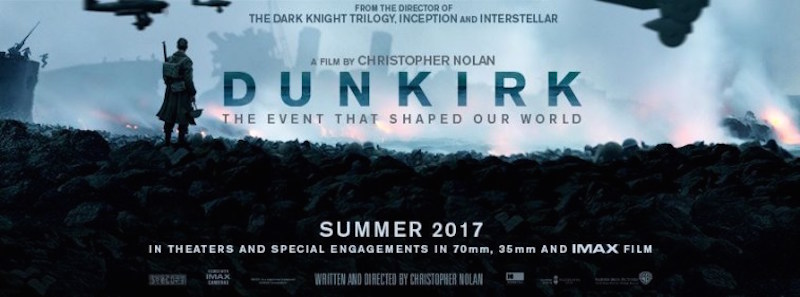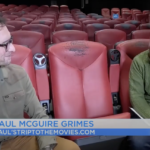DUNKIRK
Writer/Director: Christopher Nolan
Starring: Fionn Whitehead, Mark Rylance, Tom Hardy, Cillian Murphy, Kenneth Branagh, Harry Styles, Jack Lowden
Dunkirk is yet another example of how Christopher Nolan can masterfully tackle any genre. Over the past decade, we’ve seen him go through space and time continuums with Interstellar, a superhero saga with The Dark Knight Trilogy, and dive deep into our dreams and subconscious with Inception. All of his films tell vastly different stories, yet are unmistakably his movies. With Dunkirk, he turns to the harrowing World War II battle in France between the Allies and the Germans. The British and French armies have been driven to the shore, trapped on the beach hoping for some sort of miracle rescue mission. The Battle at Dunkirk lasted from May 26 to June 4, 1940.
Along with directing, Nolan wrote the script and has made it as bare bones as possible. The dialogue is sparse, but you’ll hardly notice. It’s worth noting the difference here versus the wordy and often lofty concepts found in Interstellar. He tells this story using three different narratives as a way to approach the battle and rescue mission. He comes at it by air, sea, and by land each having a varied timeframe on where they enter the overall scope of the rescue. We first meet Tommy (Whitehead), a British soldier awaiting rescue on the shore with a cavalry of other young soldiers including Harry Styles as Alex. The air sequences have Tom Hardy and Jack Lowden as two Air Force pilots attempting to take down the German planes before they bomb the men at sea. It’s a race against time for them as Hardy’s character is losing fuel. Nolan’s third narrative involves Oscar winner Mark Rylance who takes his son and the son’s best friend out on a small yacht to rescue any soldiers lost at sea or stuck at Dunkirk. One of their rescues involves frequent Nolan collaborator Cillian Murphy who’s stranded on an overturned boat. Murphy’s soldier is shell-shocked and refuses to head anywhere near Dunkirk again. Nolan interweaves these storylines as the rescue mission intensifies. Due to each narrative lasting in a different timeframe, it may get a bit confusing keeping it all straight.
Dunkirk starts at an already intense level as we watch Tommy and his friends running from the enemy for safety. You may notice that Nolan never refers to the enemy as the Germans or Nazis. It’s not needed as you can already feel their presence. Nolan doesn’t waste time with exposition or character buildup. Its runtime is kept well below two hours, which is Nolan’s shortest film to date after his debut Following. He keeps it running at a brisk pace keeping that ticking clock ever present. This concept is supported with the urgency in Hans Zimmer’s score. Zimmer has repeatedly worked with Nolan, and you can hear similarities in The Dark Knight Trilogy scores. Nolan’s relationship with cinematographer Hoyte Van Hoytema (Interstellar) and the importance of shooting this on 65mm and IMAX cameras is a crowning achievement when you look at the scope of the landscape at hand. The larger size offers a wider and bigger picture creating that vast emptiness you feel in the middle of the ocean or in the aerial sequences. The opposite can be true when they use them inside a vessel or inside the cockpit of the plane. I felt the claustrophobic nature of being crammed inside a tiny space with the other soldiers. It’s this immersive feeling that can be lacking in war movies that go for a broader, more generic approach when the director tries to tell too big of a story.
What Nolan does so well in Dunkirk is create an intimacy with the characters. For a film primarily lacking in the traditional sense of character introductions, Nolan gets you to care about these soldiers and the impact of the Dunkirk mission. Their plight is fully understood without knowing where they came from and the lives they had prior to the war. His young actors are mostly unknowns with the exception of former One Direction member Harry Styles who’s never made a movie before. They’ve created a bond of brotherhood between them as tension and hopelessness mounts. We see the same in the Mark Rylance scenes on the yacht. Rylance is exceptional at small, subtle choices. He has that paternal nature to him as he hopes to instill the same noble values in his son. His son, in turn, cares deeply and grows concern about his friend on board after they rescue Cillian Murphy. As the stories are weaving together, we get a glimpse of Murphy’s past and he fills in the extra with his frightened demeanor.
To put it blankly, this is best war film since Steven Spielberg’s Saving Private Ryan. Nolan captures the grueling nature at hand while keeping the emotional aspects of the story front and center. He manages to keep it lean and to the point. He doesn’t veer off into side stories with romantic interests back home. He takes that less is more approach despite the three narratives running at the same time. It feels like a lot, but Nolan shows quite a bit of constraint and leaves quite a bit to the audience to piece together. Unlike Mel Gibson’s Hacksaw Ridge, there’s very little blood or decimated bodies being thrown all over the place. There’s a death that is only accounted for after the fact. You never see Tom Hardy’s face until the end of the film as it’s wearing a pilot’s mask. The battle at Dunkirk is not a well-known part of World War II, so it’s important to see it for the historical context and learn what happened to the French and British soldiers who were stationed there. It has a PG-13 rating and should be used as a teaching tool for students – not only about world history, but filmmaking and the benefits of shooting on film versus digital cameras.
Like any good war movie, it’s one hell of a gauntlet. Nolan cares deeply about the cinematic experience, and his passion is found in the work. When he shoots a film on IMAX, it’s worth shelling out the extra bucks to see it on the biggest screen you can find with the most precise sound system. It’s loud and in your face and the reason why going to the theater is so important for a movie like this. You’ll be glued to the edge of your seat with your eyes staring at the screening. There’s no time for checking your phone, getting popcorn, or going to the bathroom. I sat in awe from the very first frame wanting to take in every picture and every moment Nolan captures on screen. I left our press screening knowing I had to see it all over again.
Is It Worth Your Trip to the Movies? Christopher Nolan has another masterpiece on his hands.
RATING: 5 out of 5 TICKET STUBS







One response to “Movie Review: DUNKIRK”
[…] Citizen Charlie (5) Keith Loves Movies (5) Lambcast (5) The Main Damie (5) Movie Review 101 (5) Paul’s Trip to the Movies (5) Sean Kelly on Movies (5) Surrender to the Void (5) Cinejour (4.5) Dan the Man’s Movie […]